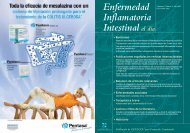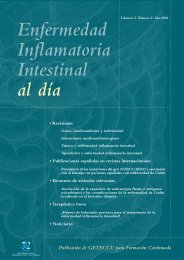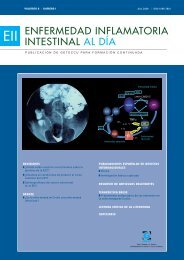ColestiraminaLa colestiramina puede utilizarse libremente en el embarazo,sobre todo en pacientes con diarrea secundariaa ileítis termin<strong>al</strong> o resección ile<strong>al</strong> (54) .LactanciaLas ventajas de la lactancia materna son ampliamenteconocidas, siendo una de ellas el menor riesgo que ellactante tiene de desarrollar <strong>EII</strong> posteriormente (88) . Detodas formas, la lactancia es una preocupación primordi<strong>al</strong>en las pacientes que temen por la seguridad de suslactantes.En un estudio llevado a cabo durante el postparto seencontró que solamente el 44% de madres con <strong>EII</strong> optabanpor la lactancia materna y que esta decisión estabainfluenciada por factores que iban desde la recomendaciónmédica y el miedo a interacciones farmacológicas,hasta la decisión person<strong>al</strong> (52) . En nuestro medio,un estudio reciente corroboró que la lactancia maternaera significativamente menos frecuente en los hijos nacidosdespués del diagnóstico de <strong>EII</strong> en comparación conlos nacidos antes del diagnóstico (33) . Sin embargo, existentratamientos que pueden ser utilizados con seguridad,como son la sulfas<strong>al</strong>azina, la mes<strong>al</strong>azina y los esteroidestópicos y or<strong>al</strong>es. Del resto de fármacos o se disponede poca información o están contraindicados porsu riesgo potenci<strong>al</strong>, como son metotrexate, ciclosporina,micofenolato de mofetilo, tacrolimus, ciprofloxacinoo metronidazol. Existe un grupo de fármacos cuyautilización debe ser individu<strong>al</strong>izada según los requerimientosmaternos por su potenci<strong>al</strong> toxicidad, a pesar deque la información sobre sus efectos en los lactantes esmínima; entre ellos se encuentran azatioprina, 6-mercaptopurinay los anti-TNF (89) .ConclusionesLa posibilidad de una gestación s<strong>al</strong>udable es una preocupaciónprimordi<strong>al</strong> en el curso evolutivo de los pacientesjóvenes con <strong>EII</strong>. Por tanto, es importante transmitir a lospacientes que tanto la fertilidad como la morbimort<strong>al</strong>idadmaterno-fet<strong>al</strong> de las gestaciones no suelen estar aumentadasrespecto a la población gener<strong>al</strong>, y que sólo lasconcepciones durante periodos de actividad de la <strong>EII</strong>, elantecedente de cirugía pélvica (proctectomía, reservorioíleo-an<strong>al</strong>) y determinados fármacos, pueden cambiarlo.El embarazo es un momento idóneo para reforzar elabandono del tabaquismo.Por último, debería fomentarse la lactancia materna enpacientes con <strong>EII</strong> puesto que podría reducir la incidenciade <strong>EII</strong> en los hijos; para ello es cruci<strong>al</strong> disponer deuna mayor información acerca del paso de ciertos fármacoscomo las tiopurinas o los agentes biológicos a l<strong>al</strong>eche materna y su potenci<strong>al</strong> efecto <strong>al</strong> ser ingeridos porlos recién nacidos.BIBLIOGRAFÍA1. Beattie RM, Croft NM, Fell JM, et <strong>al</strong>. Inflammatory bowel disease. Arch.Dis. Child. 2006;91;426-32.2. Shivananda S, Lennard-Jones J, Logan R, et <strong>al</strong>. Incidence of InflammatoryBowel Disease across Europe: is there a difference between North andSouth? Result of the European Collaborative Study on inflammatory boweldisease. Gut 1996;39:690-7.3. Fonager K, Sorensen HT, Olsen J, et <strong>al</strong>. Pregnancy outcome for womenwith Crohn’s disease : A follow-up study based on linkage between nation<strong>al</strong>registries. Am J Gastroenterol 1998;93:2426-230.4. Orholm M, Munkholm P, Langholz E, et <strong>al</strong>. Famili<strong>al</strong> occurrence of inflammatorybowel disease. N Engl J Med 1991;324:84-8.5. Bennett RA, Rubin PH, Present DH. Frequency of inflammatory bowel diseasein offspring of couples both presenting with inflammatory boweldisease. Gastroenterology 1991;100:517-24.6. Lamah M, Scott HJ. Inflammatory bowel disease and pregnancy. Int J Colorect<strong>al</strong>Dis 2002;17:216-22.7. Moody GA, Probert C, Jayanthi V, et <strong>al</strong>. The effects of chronic ill he<strong>al</strong>thand treatment with sulphas<strong>al</strong>azine on fertility amongst men and womenwith inflammatory bowel disease in Leicester. Int J Colorect<strong>al</strong> Dis1997;12:220-4.8. Moody G, Probert C, Srivasta, et <strong>al</strong>. Sexu<strong>al</strong> dysfunction amongst patientswith inflammatory bowel disease. Digestion 1993;52:256-60.9. Marri S, Ahn C, Buchman A. Voluntary Childlessness is increased in womenwith inflammatory bowel disease. Inflamm Bowl Disease 2007;13:591-9.10. Mayberry JF, Weterman IT. European survey of fertility and pregnancy inwomen with Crohn’s disease: a case control study by European collaborativegroup. Gut 1986;27:821-5.11. Olsen KO, Juul S, Berndtsson, et <strong>al</strong>. Ulcerative colitis: fem<strong>al</strong>e fecundity beforediagnosis, during disease and after surgery compared to a populationsample. Gastroenterology 2002;122:15-9.12. W<strong>al</strong>jee, A., W<strong>al</strong>jee J, Morris AM, Higgins PD. Threefold increased risk ofinfertility: a meta-an<strong>al</strong>ysis of infertility after ile<strong>al</strong> pouch an<strong>al</strong> anastomosisin ulcerative colitis. Gut, 2006;55:1575-80.13. Mortier PE, Gambiez L, Karoui M, et <strong>al</strong>. Colectomy with ileorect<strong>al</strong> anastomosispreserver fem<strong>al</strong>e fertility in ulcerative colitis. Gastroenterol ClinBiol 2006;30:594-7.14. O’Morain C, Smethurst P, Dore CJ, et <strong>al</strong>. Reversible m<strong>al</strong>e infertility due tosulphas<strong>al</strong>azine: studies in man and rat. Gut 1984;25:1078–84.15. Kjaergaard N, Christensen LA, Lauritsen JG, et <strong>al</strong>. Effects of mes<strong>al</strong>azinesubstitution on s<strong>al</strong>icylazosulfapyridine-induced semin<strong>al</strong> abnorm<strong>al</strong>ities inmen with ulcerative colitis. Scand J Gastroenterol 1989;24:891–616. Farthing MJ, Dawson AM, Impaired semen qu<strong>al</strong>ity in Crohn’s diseasedrugs,ill he<strong>al</strong>th, or undernutrition? Scan J Gastroenterol 1983;18:57-60.17. El-Tawil AM. Zinc deficiency in men with Crohn’s disease may contributeto poor sperm function and m<strong>al</strong>e infertility. Andrologia 2003; 35:337-41.18. Dejaco C, Mittermaier C, Reinisch W. Azathioprine treatment and m<strong>al</strong>efertility in inflammatory bowel disease. Gastroenterology2001;121:1048–53.19. French AE, Koren G. Effect of methotrexate on m<strong>al</strong>e fertility. Can FamPhysician 2003;49:577-8.168 • Enfermedad Inflamatoria Intestin<strong>al</strong> <strong>al</strong> día - Vol. 7 - Nº. 2 - 2008
Revisiones20. Mahadevan U. Fertility and pregnancy in the patient with inflammatorybowel disease. Gut. 2006;55:1198-20621. Mahadevan U, Terdiman J, Aron J, et <strong>al</strong>. Infliximab and semen qu<strong>al</strong>ity inmen with inflammatory bowel disease. Inflamm Bowel Dis 2007;11:395-9.22. Gorgun ERF, Montague D, Connor J, et <strong>al</strong>. M<strong>al</strong>e sexu<strong>al</strong> function improvesafter ile<strong>al</strong> pouch an<strong>al</strong> anastomosis. Colorect Dis 2005;7:545-50.23. Tiainen J, Matikainen M, Hiltunen KM. Ile<strong>al</strong> J-pouch-an<strong>al</strong> anastomosis, sexu<strong>al</strong>dysfunction, and fertility. Scand J Gastroenterol 1999;34:185-8.24. Narendranathan M, Sandlres RS, Suchindran CM. M<strong>al</strong>e infertility in inflammatorybowel disease. J Clin Gastroenterol 1989;11:403-6.25. Bauer JJ, Gelernt IM, S<strong>al</strong>k BA, Kreel I. Proctectomy for inflammatory boweldisease. Am J Surg. 1986;151:157-62.26. Riis L, Vind I, Politi P, et <strong>al</strong>. On beh<strong>al</strong>f of the European Collaborative studygroup on inflammatory bowel disease (EC-IBD). Does pregnancy changethe disease course? A Study in a European Cohort of Patients with InflammatoryBowel Disease. Am J Gastroenterol 2006;101:1539-45.27. Kornfeld D, Cnattignuis S, Ekbom A. Pregnancy outcomes in women withinflammatory bowel disease. A population-based cohort study. Am J ObstetGynaecol 1997;177:942–6.28. Larzilliere I, Beau P. Chronic inflammatory bowel disease. Case controlstudy. Gastroenterol Clin Biol 1998;22:1056–60.29. Tennenbaum R, Marteau P, Elefant, et <strong>al</strong>. Pregnancy outcome in inflammatorybowel diseases. Gastroenterol Clin Biol 1999;23:464–9.30. Fonager K, Sorensen HT, Olsen J, et <strong>al</strong>. Pregnancy outcomes for womenwith Crohn’s disease—a follow-up study based on linkage between nation<strong>al</strong>registers. Am J Gastroenterol 1988;93:3426–30.31. Nørgård B, Fonager K, Sorensen HT, et <strong>al</strong>. Birth outcomes of women withulcerative colitis: a nationwide Danish cohort study. Am J Gastroenterology2000;95:3165–70.32. Baird D, Narendranathan M, Sandler R. Increased risk of preterm birth forwomen with inflammatory bowel disease. Gastroenterology 1990;99:987-94.33. Navarro-Llavat M, Mañosa M, Marín L, et <strong>al</strong>. Fertilidad en pacientes conenfermedad inflamatoria intestin<strong>al</strong>. Gastroenterol Hepatol 2008;31:167.34. de Vos M, Cuvelier C, Mielants H, et <strong>al</strong>. Ileocolonoscopy in seronegativespondylarthropathy. Gastroenterology 1989;96:339-44.35. Gould SR, Brash AR, Conolly ME, Lennard-Jones JE. Studies of prostaglandinsand sulphas<strong>al</strong>azine in ulcerative colitis. Prostaglandins Med1987;6:165-82.36. Mantyh PW, Mantyh CR, Gates T, et <strong>al</strong>. Receptor binding sites for substanceP and substance K in the canine gastrointestin<strong>al</strong> tract and their possiblerole in inflammatory bowel disease. Neuroscience 1988;25:817-37.37. C<strong>al</strong>derwood AH, Kane SV. IBD and pregnancy. Med Gen Med 2004; 6:14.38. Regueiro M, Kip KE, Cheung O, et <strong>al</strong>. Cigarrette smoking and age at diagnosisof inflammatory bowel disease. Inflamm Bowel Dis 2005;11:42-7.39. Lambers DS, Clark KE. The matern<strong>al</strong> and fet<strong>al</strong> physiologic effects of nicotine.Semin Perinatol 1996;20-115-26.40. Ferrero S, Ragni N. Inflammatory bowel disease: management issues duringpregnancy. Arch Gynaecol Obstet 2004;270:79-85.41. Subhani JM, Hamiliton MI. Review article: the management of inflammatorybowel disease during pregnancy. Aliment Pharmacol Ther 1998;12:1039–54.42. Alstead EM. Inflammatory bowel disease and pregnancy. Postgrad Med J2002;78:23-6.43. Katz JA. Endoscopy in the pregnant patient with inflammatory bowel disease.Gastrointest Endosc Clin N Am 2002;12:635-46.44. Mahadevan U. American Gastroenterologic<strong>al</strong> Association Institute technic<strong>al</strong>review on the use of gastrointestin<strong>al</strong> medications in pregnancy. Gastroenterology2006;131:283–311.45. Rimensberger P, Schubiger G, Willi U. Connat<strong>al</strong> rickets following repeatedadministration of phosphate enemas in pregnancy: a case report. EurJ Pediatr. 1992;151:54-6.46. Nielsen OH, Andreasson B, Bondesen S, Jarnum S. Pregnancy in ulcerativecolitis. Scand J Gastroenterol 1983;18:735-742.47. Willoughby CP, Truelove SC. Ulcerative colitis and pregnancy. Gut1980;21:469-74.48. Anderson JB, Turner GM, Williamson RC. Fulminant ulcerative colitis inlate pregnancy and puerperium. J R Soc Med 1987;80:492-4.49. Ravid A, Richard CS, Spencer LM. Pregnancy, delivery and pouch functionafter ile<strong>al</strong> pouch-an<strong>al</strong> anastomosis for ulcerative colitis. Dis Colon Rectum2002;45:1283-8.50. Kholsa R, Willoughby CP, Jewel DP. Crohn’s disease and pregnancy. Gut1984;25:52-6.51. Beniada A, Benoist G, Maurel J, Dreyfus M. Inflammatory bowel diseaseand pregnancy:report of 76 cases and review of the literature. J GynecolObstet Biol Reprod 2005;34:581-8.52. Kane S, Lemieux N. The role of breastfeeding in postpartum disease activityin women with inflammatory bowel disease. Am J Gastroenterol2005;100:102-5.53. Hill J, Clark A, Scott NA. Surgic<strong>al</strong> treatment of acute manifestations ofCrohn’s disease during pregnancy. J R Soc Med 1997;90:64-6.54. Caprilli R, Gassull MA, Escher JC, et <strong>al</strong>. European Crohn’s and Colitis Organisation.European evidence based consensus on the diagnosis and managementof Crohn’s disease: speci<strong>al</strong> situations. Gut 2006;55 (Suppl.1):i36-58.55. Peppercorn M. Fertility, pregnancy, and nursing in inflammatory bowel disease,from the UpToDate in Gastroenterology and Hepatology, AmericanGastroenterology Association, June 2005.56. Hansloser D, Pemberton JH, Wolff BG, et <strong>al</strong>. Pregnancy and delivery beforeand after ile<strong>al</strong> pouch-an<strong>al</strong> anastomosis for inflammatory bowel disease:immediate and long-term consequences and outcomes. Dis ColonRectum 2004;47:1127-35.57. Fedorkow DM, Persaud D, Nimrod CA. Inflammatory bowel disease:a controlledstudy of late pregnancy outcome. Am J Obstet Gynaecol1989;160:998-1001.58. Kroser, J. and R. Srinivasan, Drug therapy of inflammatory bowel diseasein fertile women. Am J Gastroenterol, 2006. 101(12 Suppl): p. S633-639.59. Nørgård B, Czeizel AE, Rockenbauer M, et <strong>al</strong>. Population-based case controlstudy of the safety of sulphas<strong>al</strong>azine use during pregnancy. AlimentPharmacol Ther 2001;15:483-6.60. Mogadam M, Dobbins WO, Korelitz BI, et <strong>al</strong>. Pregnancy in inflammatorybowel disease: effect of sulfas<strong>al</strong>azine and corticosteroids on fet<strong>al</strong> outcome.Gastroenterology 1981;80:72-6.61. Esbjoner E, Jarnerot G, Wranne L. Sulphas<strong>al</strong>azine and sulphapyridine serumlevels in children to mothers treated with sulphas<strong>al</strong>azine during pregnancyand lactation. Acta Paediatr Scand 1987;76:137-42.62. Colombel JF, Brabant G, Gubler MC, et <strong>al</strong>. Ren<strong>al</strong> insufficiency in infant:sideeffectof prenat<strong>al</strong> exposure to mes<strong>al</strong>azine? Lancet 1994;344:620-1.63. Marteau P, Seksik P, Beaugerie L, et <strong>al</strong>. Recommendations for clinic<strong>al</strong> practicefor the treatment of ulcerative colitis. Gastroenterol Clin Biol 2004;28(10 Pt2):955-60.64. Park-Wyllie L, Mazzotta P, Pastuszak A, et <strong>al</strong>. Birth defects after matern<strong>al</strong>exposure to corticosteroids: prospective cohort study and meta-an<strong>al</strong>ysisof epidemiologic<strong>al</strong> studies. Teratology 2000;62:385-92.169 • Enfermedad Inflamatoria Intestin<strong>al</strong> <strong>al</strong> día - Vol. 7 - Nº. 2 - 2008











